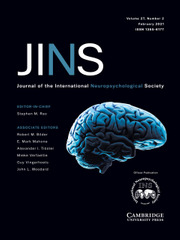Regular Research
Neuropsychological Change After a Single Season of Head Impact Exposure in Youth Football
-
- Published online by Cambridge University Press:
- 07 August 2020, pp. 113-123
-
- Article
- Export citation
A Multidimensional Assessment of Metacognition Across Domains in Multiple Sclerosis
-
- Published online by Cambridge University Press:
- 10 August 2020, pp. 124-135
-
- Article
- Export citation
Emotion Recognition and Traffic-Related Risk-Taking Behavior in Patients with Neurodegenerative Diseases
-
- Published online by Cambridge University Press:
- 19 August 2020, pp. 136-145
-
- Article
-
- You have access
- Open access
- HTML
- Export citation
Aggregation of Abnormal Memory Scores and Risk of Incident Alzheimer’s Disease Dementia: A Measure of Objective Memory Impairment in Amnestic Mild Cognitive Impairment
-
- Published online by Cambridge University Press:
- 10 August 2020, pp. 146-157
-
- Article
- Export citation
Integrating Three Characteristics of Executive Function in Non-Demented Aging: Trajectories, Classification, and Biomarker Predictors
-
- Published online by Cambridge University Press:
- 10 August 2020, pp. 158-171
-
- Article
- Export citation
Metabolic Syndrome and Physical Performance: The Moderating Role of Cognition among Middle-to-Older-Aged Adults
-
- Published online by Cambridge University Press:
- 10 August 2020, pp. 172-180
-
- Article
- Export citation
Validation of the Virtual Reality Everyday Assessment Lab (VR-EAL): An Immersive Virtual Reality Neuropsychological Battery with Enhanced Ecological Validity
-
- Published online by Cambridge University Press:
- 10 August 2020, pp. 181-196
-
- Article
- Export citation
Brief Communication
Loss of Consciousness is Associated with Elevated Cognitive Intra-Individual Variability Following Sports-Related Concussion
-
- Published online by Cambridge University Press:
- 10 August 2020, pp. 197-203
-
- Article
- Export citation
Is the Weigl Colour-Form Sorting Test Specific to Frontal Lobe Damage?
-
- Published online by Cambridge University Press:
- 10 August 2020, pp. 204-210
-
- Article
- Export citation
Front Cover (OFC, IFC) and matter
INS volume 27 issue 2 Cover and Front matter
-
- Published online by Cambridge University Press:
- 11 February 2021, pp. f1-f2
-
- Article
-
- You have access
- Export citation
Back Cover (OBC, IBC) and matter
INS volume 27 issue 2 Cover and Back matter
-
- Published online by Cambridge University Press:
- 11 February 2021, pp. b1-b2
-
- Article
-
- You have access
- Export citation

